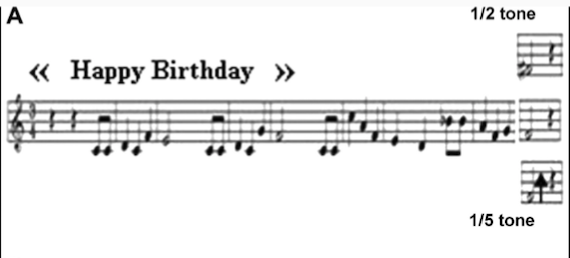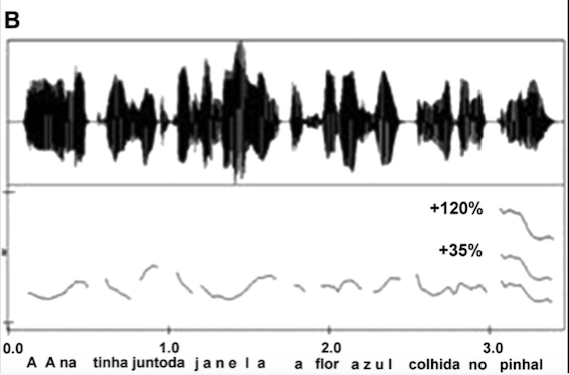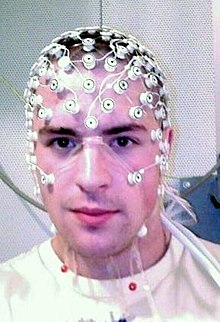Title of paper under discussion
Musical Training Influences Linguistic Abilities in 8-Year-Old Children: More Evidence for Brain Plasticity
Authors
Sylvain Moreno, Carlos Marques, Andreia Santos, Manuela Santos, São Luís Castro, Mireille Besson
Journal
Cerebral Cortex, Volume 19, Issue 3, March 2009, Pages 712–723
Link to original paper (open access)
Overview
The idea that passively listening to music can improve your general cognitive ability – the ‘Mozart effect’ – remains controversial. But active musical expertise has been shown time and again to be associated with differences in brain structure and function. Are these brain differences brought on by musical training, or are they there from birth, predisposing that person to become a musician?
This paper – a study over time, or a ‘longitudinal study’ – addresses that question by taking a big group of musically untrained children; half of them are given music lessons and half of them painting lessons, all over six months. Before and after the training period their music and language abilities are assessed both by standard tests and by brain monitoring.
The musically trained children ended up not only doing better in some reading and speech recognition tasks than their painting-trained classmates; they also developed different patterns of brain activity in response to music and speech, pointing to brain changes that account for this transferability of musical skills to linguistic skills.
Method
32 Portuguese children took part in the project – their parents were delighted because their children were getting free training (in music or art) and got to go on a free trip to a concert or an art gallery.
The experiment was divided into three phases:
PHASE ONE
Each of the 32 children was given various tests at the start of the project:
1) IQ: including maths, vocab, picture completion, reverse order memory etc.
2) Reading skill: reading out loud words of various complexity.
3) Music pitch discrimination: judging whether the final note of “Happy Birthday” (see below) – which was variously at the correct pitch, 1/5 tone sharp (‘weak incongruity’) or a semitone sharp (‘strong incongruity’) – sounded ‘normal’ (congruous) or ‘strange’ (incongruous).

4) Speech pitch discrimination: judging whether the final word in a Portuguese sentence (see below) – which was variously at the correct pitch, 35% sharp (‘weak incongruity’) or 120% sharp (‘strong incongruity’) – sounded ‘normal’ (congruous) or ‘strange’ (incongruous).

5) Musical pitch brain response: whereby electrical activities in the brain – ‘event-related potentials’ or ‘ERPs’ – were monitored during and after the presentation of the last note of Happy Birthday to see how the brain responded variously to the in tune note (congruous), the 1/5 tone sharp note (weakly incongruous) and to the semitone sharp note (strongly incongruous). The ERP was only recorded if the child had correctly identified whether the last note was ‘strange’ (incongruous) or ‘normal’ (congruous).

6) Speech pitch brain response: a similar test to test 5), this time measuring ERPs in response to the different pitches of the final word of the sentence (if correctly identified).
PHASE TWO
The children were randomly divided into two groups, those to receive training in music and those to receive training in painting. The trainee musicians went on to receive twice-weekly lessons (for 24 weeks excluding holidays) in rhythm, melody, harmony, timbre and form. The trainee painters received an equal number of lessons in light/colour, line/perspective and material/texture. The music group children gave a public performance at the end of the school year and the painting group children gave a public exhibition of their artwork.
PHASE THREE
Each child was put through the same testing procedure as in Phase One.
Results
1) IQ: There was a general improvement in all the children’s IQs over the 6 months; the musically trained children showed a bigger increase, but the difference in increase between the two groups wasn’t statistically significant.
2) Reading skills: Musically trained children showed a significant increase in their ability to read difficult-to-pronounce words; this was not matched by the painting group.
3) Music pitch discrimination: Both groups of children showed similar improvement after the 6 months in their ability to recognise that the ‘in tune’ ending of Happy Birthday was ‘normal’ and the ‘semitone sharp’ ending was ‘strange’. But only the musically trained group improved significantly in their ability to recognise the ‘1/5 tone sharp’ (weakly incongruous) endings as ‘strange’.
4) Speech pitch discrimination: Neither of the training groups showed a significant improvement in discerning the ‘in tune’ (congruous) final word as ‘normal’ and the ‘120% sharp’ (strongly incongruous) final word as ‘strange’. However, just as in the music pitch discrimination results, the musically trained group of children were better able to judge the weak incongruity (‘35%’ pitch increase) in the final word of the sentence after the 6 months, whereas the painting group showed no improvement in this task either.
5) Musical pitch brain response: musical training significantly enhanced an ERP called ‘N300’ in response to the ‘1/5 tone sharp’ (‘weak incongruity’) final note of Happy Birthday, whereas painting training did not. ‘N300’ is a negative spike in electric potential, detected by the scalp electrodes, about 300 milliseconds after the final note was played. The spike was visible before and after training in both groups, and after all the final notes, whether they were ‘in tune’, ‘1/5 sharp’ or ‘semitone sharp’. But 6 months musical training increased the height of that spike significantly in response to the ‘1/5 tone sharp’ note (though the spike remained the same height for the ‘in tune’ note and the ‘semitone sharp’ note). No increases in the ‘N300’ spike after any of the Happy Birthday endings were seen after 6 months training in painting.
6) Speech pitch brain response: musical training significantly enhanced an ERP called ‘P200-900’ in response to the ‘35% sharp’ (weakly incongruous) final word in the sentence, and reduced it in response to the ‘120% sharp’ (strongly incongruous) final word. ‘P200-900’ is a long-lasting positive spike in electric potential, starting 200 milliseconds after the final word and ending 900ms after it. Only the musically trained children showed these changes in the height of this spike after their 6 months training; the ‘P200-900’ spike remained the same height in response to all final word pitches after 6 months in the painting group’s results.
Discussion
In relation to the finding that the IQ enhancement was greater in the musically trained group, but not statistically significantly so, Moreno suggests a bigger study might have revealed a genuine enhancement.
The finding that reading skills were enhanced by musical training is discussed in relation to research on dyslexia being associated with poor musical perception. The authors hypothesise that musical training “improves the development of phonological representations necessary for reading”, and cite papers finding that pitch discrimination was impaired in children with dyslexia.
Also discussed, in the context of the positive effect of musical training on speech discrimination, is previous research finding that musical expertise has a facilitatory effect on second language perception and learning.
The finding that musical training increased the height of the ‘N300’ ERP after the ‘1/5 tone sharp’ (weakly incongruous) ending of Happy Birthday did not come as a surprise to Moreno and his colleagues – such differences in ERP in musically trained adults and children compared with non-musicians had been described by other researchers. And the increased height of the musically trained group’s ‘P200-900’ ERP in response to the ‘35% sharp’ (again, weakly incongruous) final word of the Portuguese sentence again showed a transfer effect from music to speech processing, an effect supported by previous research demonstrating that musicians code the acoustic attributes of language more faithfully in their brainstems than do non-musicians.
A reduction in the height of the ‘P200-900’ ERP when a musically trained child correctly identified a ‘strongly incongruent’ final word of Portuguese sentence, as compared to a musically untrained child making the same correct identification, suggested to the researchers that such training had made the brain more efficient and automatic at processing more obvious pitch discrepancies. This ties in with other research showing decreased activation in different brain regions with increased musical practice.
The researchers conclude that overall this study adds to the “growing evidence ” in animal and human research, in adults and children, that “relatively short periods of training have profound consequences on the anatomical and functional organisation of the brain”. Specifically in this case, influence is “shown to generalise from music to speech perception and reading skills; these transfers highlight the commonality of pitch processing in music and speech”.
Coda
Domingos Bomtempo – Piano Concerto no 1 in E flat, op.2
Nella Maissa – piano, Nuremberg Symphony Orchestra